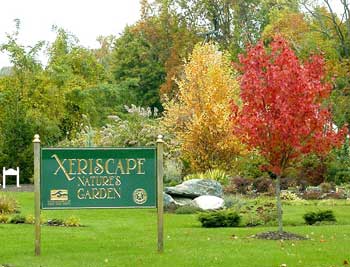Nature's Garden
Water Conservation and
Beautiful Landscapes
A Cooperative
Project of the
Water Authority of Great Neck North and Nassau County

A major focus of
the Water Authority of Great Neck North's conservation efforts is
public education. The Xeriscape, a joint project between the
Water Authority and Nassau County, is a unique demonstration of
the many possibilities for creating beautiful landscape design
while significantly conserving our precious water supply.
Developed for the educational benefit of Great Neck peninsula
residents as well as homeowners throughout Nassau County, the
Xeriscape was designed in landscape form. In this manner the
Xeriscape demonstrates the broad array of of beautiful lawn and
planting areas that can be incorporated into the landscapes of
private homes, building complexes and public park areas. The
Xeriscape also exemplifies the wonderful variety and color that
can be achieved through water-efficient landscaping.
It is the hope of
the Water Authority that you will enjoy our Xeriscape and be
encouraged to create your own Xeriscape, thereby conserving water
and saving costs while enjoying the treasures of this unique
landscaping style.
WHAT
IS A XERISCAPE
Xeriscape (from the Greek xeros,
for dry) was originally defined as "the conservation of water through creative
landscaping" by the Denver, Colorado Water Department in the early 1980's' The term
Xeriscaping has since come to be descriptive of any resource-efficient approach to
landscaping that emphasizes good planning, region-appropriate plants and efficient water
management. Other synonymous landscaping industry terms that are often heard today
include sustainable, resource-conserving and efficient.
PRINCIPLES OF
XERISCAPING
Planning & Design: One of the keys to creating a success- full xeriscape is
planning for different areas of landscape use. By putting plants into specific zones based
upon the functions you want your yard to serve and the water needs of the plants you
select, you can create a water-efficient landscape that is both beautiful and functional.
Typically, there are three xeriscape zones: 1) arid - usually far away from the
house, this zone features the most drought tolerant vegetation; 2) transition -
an intermediate zone that takes advantage of low and moderate water use plants
(supplemental watering once a week or less), this zone is used to blend lush
areas with the more arid parts of the landscape; and 3) lush - the area that is usually closest to the house and where the highest
water use plants are closely placed. This zone also includes the lawn area. Plants in this
zone may typically require supplemental watering no more than twice per week.
Intelligent
Turf Selection: Turf is the most water thirsty landscape component.
Design lawn areas for practical purposes; play, maintenance access and light
traffic. Select drought tolerant turfs, such as tall fescue, Buffalo grass and
Bermuda hybrids.
Efficient Irrigation: Proper irrigation choices can save water. Lawns are best
watered by sprinklers. Trees, shrubs, flowers and groundcovers are best watered with low
volume drip emitters, sprayers and bubblers. Irrigate turf areas separately from other
plantings and insure that low-water use plants receive only the minimal water they need.
Soil Analysis and Management: The addition of organic matter to the soil increases
water retention and penetration. The use of mulch (2-3 inches thick) will help keep soil
cool, reduce evaporation and weed growth. Mulch can be rocks, wood chips, bark or shredded
wood.
Region-Specific Plants: There is a place for
almost every plant in a well-designed Xeriscape garden - when located correctly. Plants
should be grouped according to their water and sun needs. This is called hydrozoning.
There are many interesting and colorful low-water use plants now available.
Ongoing Maintenance: Successful Xeriscapes are low-maintenance. Seasonal irrigation
adjustments and efficiency checks are maintenance practices that save water. Organic
fertilizers and composting can improve soil texture and maintain vigorous plant growth. A
well-designed Xeriscape also eliminates the need for chemical pesticides. This helps keep
the land surface clean, prevents air contamination, and avoids penetration of pesticides
and other chemicals over the long term into our aquifers, which are the sole source of
drinking water on Long Island.
A XERISCAPE CAN DO IT ALL
It is not enough to simply save resources...landscapes must also be both useful and
attractive. Because Xeriscapes are well-planned, they save more than just water.
Better planning, plant selection and placement means less pruning and plant removal. A smaller
lawn surface uses less fertilizer, less fossil fuels, and produces less air and noise
pollution and fewer grass clippings. Soil conservation ensures healthier plants and
reduces soil moisture and topsoil losses.
Xeriscapes are truly "nature's garden." A well-planned Xeriscape preserves plant
species and improves property values. A property designed Xeriscape will help you and your
family meet your lifestyle and aesthetic needs.
|